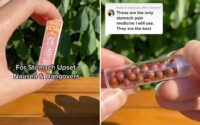Red 40 food dye in Skittles, Doritos and more trigger IBD
Maybe don’t “taste the rainbow.”
A new study published in the journal Nature Communications has revealed that a common red dye in food can increase the risk of inflammatory bowel diseases, which affect some three million Americans, according to the Crohn’s and Colitis Foundation.
The additive, denoted as Red 40 or Allura red on ingredients label, is the most prevalent dye used in many popular snacks and drinks, including Skittles, Doritos and Pepsi, as well as some cosmetics.
While the use of food coloring has increased over the years, studies on its effect in the gut are few thus far.
“What we have found is striking and alarming, as this common synthetic food dye is a possible dietary trigger for IBDs,” said McMaster University researcher Waliul Khan, the study’s senior author, in a statement. “This research is a significant advance in alerting the public on the potential harms of food dyes that we consume daily.”
The Ontario, Canada, team studied a group of mice fed high doses of Red 40 for 12 weeks — which researchers claimed was an appropriate model for humans in Western countries, where food coloring is typically a large part of people’s diets.

More specifically, they analyzed markers of common synthetic colorants in neuroendocrine intestinal cells, which play a roll in symptoms of gut inflammation, such as abdominal pain, bloating, diarrhea, dehydration and bloody stool.
They found that mice who consumed the largest amounts of Red 40 showed increased levels of serotonin — which helps regulate gut muscle movements and nutrient uptake — and interfered with healthy bacteria in the colon, leading to inflammation and ulcers of the digestive tract.

A human would need to consume a higher-than-recommended amount of the dye in order to produce the same results reported in the mice. However, even in achievable concentrations, researchers believe the biological imbalance caused by the introduction of Red 40 could make the body more susceptible to illness, in the gut and beyond.
“These findings have important implications in the prevention and management of gut inflammation,” said Khan.
“The literature suggests that the consumption of Allura Red also affects certain allergies, immune disorders and behavioral problems in children, such as attention deficit hyperactivity disorder (ADHD),” he added.
The Food and Drug Administration has a set limit on the amount of food coloring that can be used in food and cosmetics, while the recommended daily intake is no more than 3.2 milligrams per pound of a person’s body weight.
For perspective, Red 40 in juice drinks alone contributes up to 9% of the acceptable daily intake for kids of an average weight aged 6 to 10 years old. A 2014 study in the journal Clinical Pediatrics found that just one serving of Kool-Aid’s Burst Cherry drink contains more than 50 mg of various dyes.


